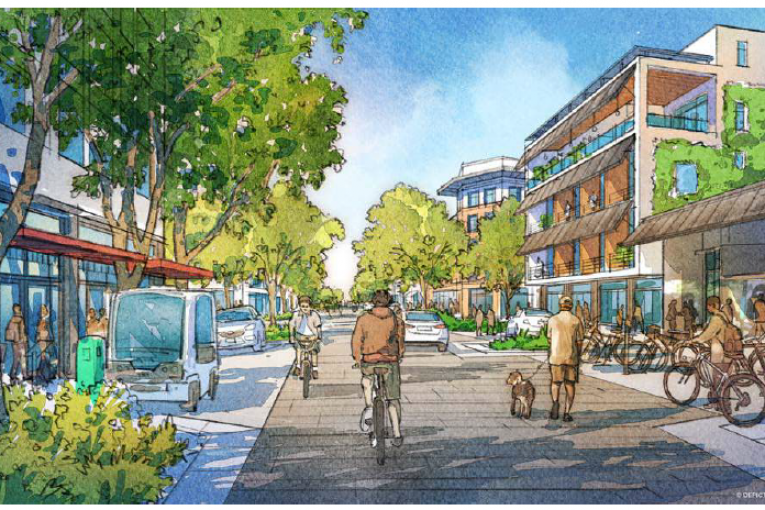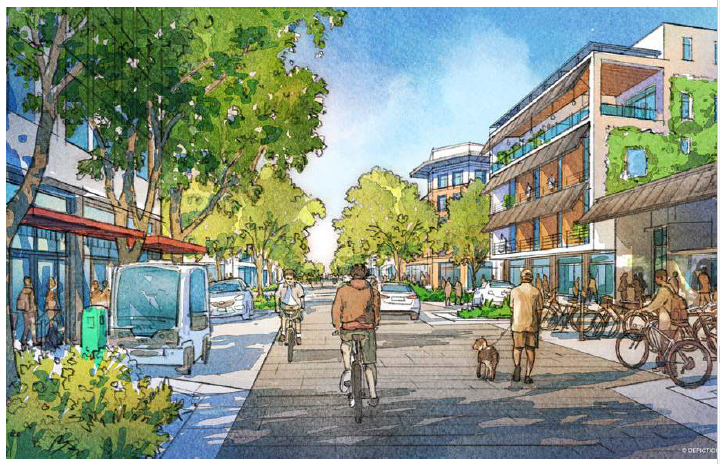

By David M. Greenwald
Executive Editor
Davis, CA -After long delays, the CEQA approval will go before the Davis Planning Commission tonight in a special meeting where the Planning Commission will recommend that the City Council adopt a resolution approving the CEQA findings and certifying the EIR.
The city began this process back in 2017, when it began the downtown plan update hoping to “guide the long term development of the downtown Davis area and address a number of recurring development challenges and community issues.”
This process led to extensive community outreach, the Draft of the Downtown Davis Specific Plan and the associated Draft Form Based Code, which were completed in 2019. The special community based DPAC completed their work in 2019, but delays and COVID meant the preparation for the EIR did not proceed until 2022.
According to the staff report, “The new Downtown Plan will replace the existing Core Area Specific Plan (CASP) and will establish the vision with overall policies and implementation actions to guide the long-term development of the specific plan area to the year 2040.”
Staff notes, “A goal of the Downtown Plan is to improve opportunities for reinvestment and development for a mix of uses in a way that is more predictable and feasible.”
The Downtown Plan includes up to 1,000 new residential units and up to 600,000 square feet of new commercial space for buildout under the plan.
“It establishes a hierarchy of built form implemented through the Form Based Code with more intense development focused in the core area and on the major commercial streets,” staff writes. The form based code, “establishes form-based zoning, which is intended to improve development certainty with more predictable built results and a high-quality public realm by using physical form, rather than separation of uses, as the organizing principle for the code.”
Staff adds, “A form-based zoning code focuses on the desired building form and addresses pertinent building elements and development requirements to achieve that form, while providing flexibility for specific architectural styles and design details.”
There are a number of changes that are required in this process, one of the biggest is that it would change the downtown area to Mixed Use, which requires a General Plan amendment that requires recommendation by the Planning Commission and final approval by the City Council which is anticipated for December 13.
Among the proposed changes includes an “Expansion of the allowable 7-story building height within the Main Street Large Zone around E Street Plaza and intervening blocks between the Amtrak Station.”
It would modify the “Building height adjustment in the Neighborhood Medium-zoned properties located on the east side of the railroad tracks and on the northern portion of the Davis Community Church site to allow a stepped-back 4th story.”
Finally it would “Rezone to include an additional portion of the University Avenue/Rice Lane Neighborhood to Neighborhood Medium – 3 stories maximum.”
While the DPAC recommendations including the one for the University Avenue/ Rice Lane neighborhood adjusting the allowable stories there and on the east side of the railroad tracks and Davis Community Church site were incorporated, other changes such as a suggestion to include the Hibbert Lumber block in a Designated Special Area were not pursued.
Staff writes, “While a Designated Special Area can provide more specific design considerations for the site, staff believes that the Form Based Code offers sufficient direction and standards.”
Staff notes, that while DPAC also included general recommendations related to affordable housing and sustainability implementation, “staff believes that the suggestions are addressed as part of existing City efforts to update the affordable housing ordinance and Climate Action and Adaptation Plan and for an implementation plan.”
Staff summarizes some of the EIR comments.
For instance one commenter expresses concern that the specific plan and its associated form based code violate SB 330, which prohibits downzoning residential properties without replacing the lost residential units elsewhere in the city.
However, “The City maintains that the proposed zoning will actually increase the amount of housing permitted on the site.”
Staff believes that “the commenter fails to take into account other applicable requirements such as on-site parking, floor area ratios, and open space requirements which would have a constraining effect on the intensity of development under the current zoning.”
They add, “What may be the most limiting factor is the allowable density for the properties. The existing Core Area Specific Plan currently limits the density to 30 dwelling units per acre.”
Another comment addressed the five stories proposed for the Hibbert site.
Currently that site is proposed to be zoned Main Street Medium which would allow up to four stories, but the property owners have requested the zoning be changed to allow up to five stories.
Staff notes, “if the request is granted, there would be a continuation of the proposed zoning along the westerly side of the railroad tracks. However, the Hibbert site does abut several existing single-story homes. It should be noted that those properties are also proposed to be zoned Main Street Medium. Therefore, if the additional story is granted to the Hibbert site, it is reasonable to consider making the entire block eligible for 5 stories.”
Finally a number of commenters have expressed concern that the Specific Plan does not satisfactorily address trees in the downtown area.
Staff responds, “It should be noted that the Specific Plan does have implementation programs, which include working out the specifics of the infrastructure plans, which include street trees. It is not likely that there will be many trees planted on private, redeveloped property because the properties in downtown Davis are relatively small (size wise) and will in all likelihood be largely covered by structures.”







I sent these comments to the Planning Commission. Members of the Sustainability Working Group had sent comments in September as well (and those are referenced here):
I support adoption of the EIR, however, with the condition that the mitigation measures for greenhouse gas (GHG) emissions proposed in Sustainability Table 8H. Implementation Actions: Sustainability on page 04A-413 in the Commission’s agenda packet also be adopted. The attached comments submitted on the Draft EIR from members of the Downtown Specific Plan Sustainability Working Group (previously appointed by the City Council) provide more detail on how those actions can be implemented.
In the Staff report at page 04A-100, under a section entitled “Mitigation Measures Considered and Determined to be Infeasible” the report erroneously states “No mitigation measures are identified…” for reducing GHG emissions to less than significant levels. Yet the report also includes at page 04A-413 in Sustainability Table 8H a list of measures intended to reduce GHG emissions. This contradiction is not explained anywhere in the document, other than with another fallacy stated at page 04A-19: “The Downtown Plan states that the sustainability measures described in Downtown Plan require additional analysis for feasibility and also notes that it can be done as part of the Climate Action and Adaptation Plan or a separate sustainability implementation plan.”
The feasibility of those proposed sustainability measures was evaluated by a group of environmental and energy policy professionals who as citizens of Davis had volunteered their time to provide the expertise that had not been supplied by either the consulting team retained or City staff. They were appointed by the City County specifically to fill that role. Further, the consultants and staff have had more than three (3) years to evaluate the feasibility of those measures to their own satisfaction. In the meantime, the feasibility, and even desirability, of those measures has become even more apparent to the team of professionals who constituted the Sustainability Working Group, and their joint comments reflect that opinion.
The Staff Report alludes to the ability to include the sustainability measures in the Climate Action and Adaptation Plan (CAAP), yet many of these were not proposed or included in a list of specific actions evaluated in the CAAP that I reviewed as a member of the Natural Resources Commission (NRC). The Staff and the CAAP consultants have had two (2) years to include and evaluate those measures as well. The apparent lack of coordination on sustainability measures between the DSP and the CAAP undermines the claim that those measures will be enacted by the City without specific inclusion as mitigation measures in the adopted EIR. The Planning Commission should instead recommend direct inclusion in the DSP EIR and subsequent coordination with the CAAP.
Finally, the version of the report in the attached agenda proposes to delete the Sustainability Working Group and its listed members in redline edits at page 04A-176. No explanation is given for removing this reference, yet Table 8H is the sole creation of this group. This edit should be rejected.
One additional comment: the Staff Report erroneously states that the Natural Resources Commission did not submit comments prior to the September 16 deadline. In fact the NRC adopted a resolution at its July 25 meeting that stated the following but is not reflected in the EIR Report and should be considered by the Planning Commission in its deliberations:
The NRC recommends the following in response to the DDSP EIR:
• Delay final approval of projects in DDSP area until the 2020-2040 Climate Action and Adaptation Plan is adopted by City Council
• Incorporate sustainability measures identified in DDSP into the mitigation measures shown in the DDSP EIR, especially for GHG and AQ chapters, rather than stating ‘Significant but Unavoidable’. These sustainability measures are tangible ways that the DDSP EIR can mitigate impacts.
The NRC adopted this resolution with the understanding that it would be an official comment on the DDSP EIR. If that was not the case, then the issue does not lie with the NRC itself as it was doing at directed by Staff. The NRC’s July 25 meeting minutes are attached.